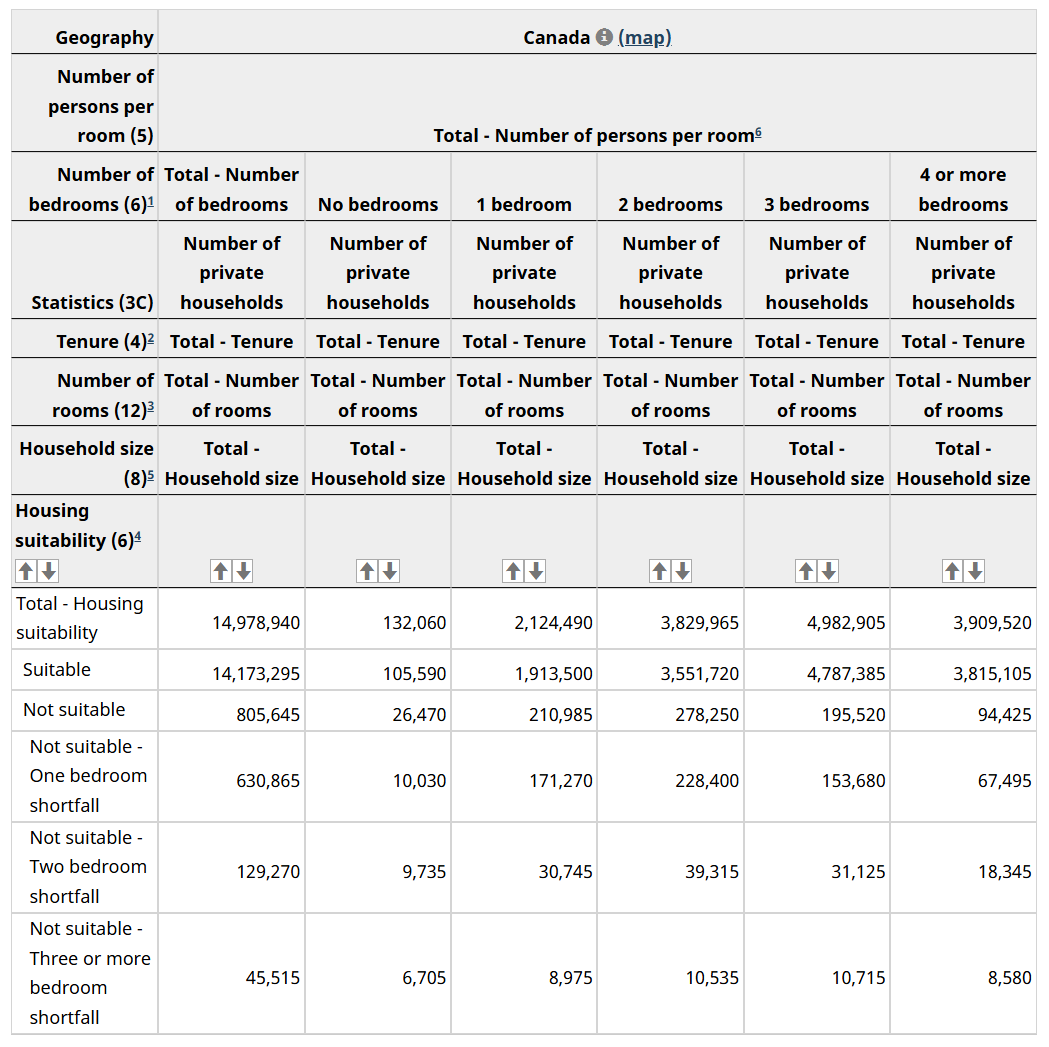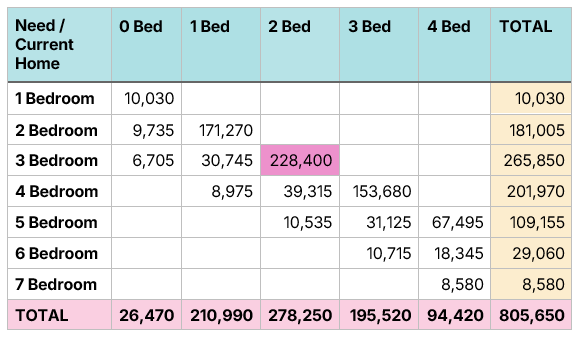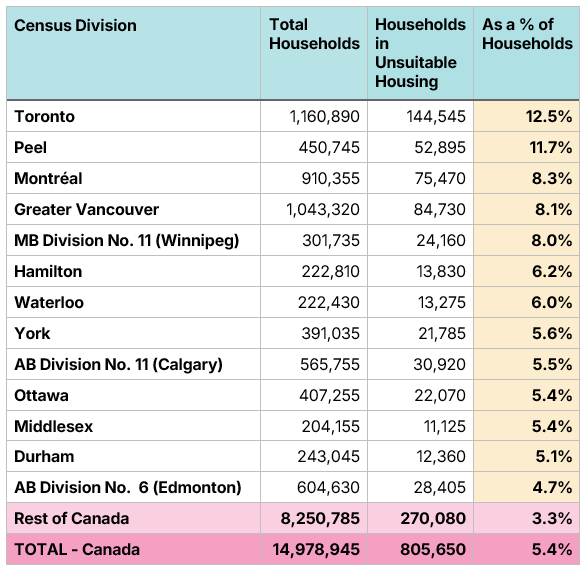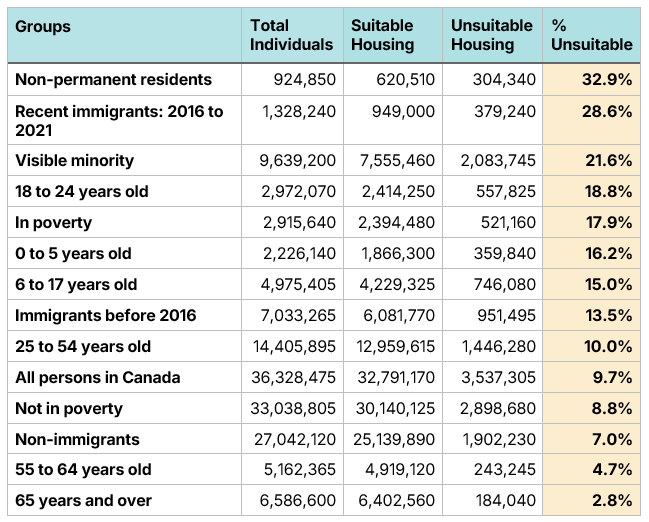Families Are Outgrowing Our Cities, and the Law Says They Shouldn’t Have To
The middle class isn’t just being priced out, it’s being sized out.
Highlights
Suitable housing, including a sufficient supply of three-bedroom and larger homes, is a human right, not a preference: Canada’s National Housing Strategy Act affirms housing as a human right under international law, requiring that homes be “suitable,” meaning they contain enough bedrooms for household members.
Over 800,000 households live in homes that are too small. As of the 2021 Census, 805,645 Canadian households (5.4% of all households), representing 3.5 million people (9.7% of the population), lived in housing that failed to meet national suitability standards.
A shortage of three- and four-bedroom homes drives the crisis: The most common mismatch is families living in two-bedroom units who need three, and nearly half of all unsuitably housed households require four or more bedrooms.
Unsuitable housing is concentrated in Canada’s largest cities: Two-thirds of all households in undersized homes reside in just 13 urban Census divisions. The City of Toronto and Peel have particularly high rates of households in unsuitably small housing at 12.5% and 11.7% respectively. Outside of these 13 urban centres, only 3.3% of households live in unsuitable housing. This reveals that urban planning and densification policies have failed to ensure livable, family-sized options.
Middle-class and family households bear the brunt: Most residents of unsuitable housing are not poor; they are middle-income families with children, underscoring that Canada’s urban housing shortage is a human-rights and middle-class issue alike.
When Cities Fail to Meet Canada’s Housing Rights Commitments
At MMI, we regularly highlight the need for Canada to have more three-bedroom (and larger) homes, as a lack of such homes causes families to leave cities or have fewer children than they wish to have. That these types of homes are not just nice to have, they are a requirement of the National Housing Strategy Act, which recognizes “that the right to adequate housing is a fundamental human right affirmed in international law”, which includes a suitability requirement that homes have enough bedrooms to support the household living in it adequately.
However, not every household chooses to leave our cities or have fewer children due to a lack of suitable housing. In fact, as of 2021, over 800,000 Canadian households lived in unsuitable housing, either by choice or necessity.
The majority of these households are middle-class, and they tend to have a higher proportion of children living at home. These households also disproportionately reside in Canada’s largest and densest cities, indicating that our governments and urban planners have been unable to densify our communities in a manner that complies with Canada’s obligations under international law to ensure adequate housing for all.
Over 800,000 Canadian households live in unsuitable housing
For a home to be considered “suitable,” it must have enough bedrooms relative to the size and composition of the household, according to the National Occupancy Standard (NOS); a definition of the standard can be found here.
The 2021 Census contains 38 different tables for examining housing-related issues. One of the tables finds that, as of 2021, 805,645 households in Canada, representing 5.4% of all households, lived in housing that is too small, and provides an estimate of the number of additional bedrooms needed for each household to be suitably housed. Statistics Canada’s presentation of that table is in Figure 1.
Figure 1: Housing suitability by number of households and bedroom shortfall, Statistics Canada presentation, Census 2021 (suitable = enough bedrooms to adequately support household)
Data and Chart Source: Statistics Canada Table 98-10-0235-01
We can tidy this chart somewhat by removing the “or more” from both “4 or more bedrooms” from the current size of the home, along with “Three or more bedroom shortfall”. That is, for the sake of presentation, we’ll make an incredibly conservative assumption and assume the “or more” values are zero.
We can then rearrange the data to examine the current size of a household’s home and the size of the home the household needs to be suitably housed, as shown in Figure 2. The top row indicates the number of bedrooms the home currently has, while the leftmost column shows the number of bedrooms needed to house the family suitably.
Figure 2: Unsuitable housing by number of households and by current number of bedrooms (top row) and needed number of bedrooms (left column), Census 2021 (suitable = enough bedrooms to adequately support household)
Data Source: Statistics Canada Table 98-10-0235-01, Chart Source: MMI.
Several data points jump out from Figure 2, including:
The most common scenario for an unsuitably housed family is one where they live in a two-bedroom home, but need a three-bedroom home to be suitably housed, highlighting the need for three-bedroom homes.
More households live in unsuitably small homes with three bedrooms or fewer than live in homes with zero or one bedroom. This highlights that often three bedrooms are not enough. Larger homes are often seen as “wasteful”, particularly by advocates of density, but they’re often necessary to house multigenerational families and other large households suitably.
Nearly half of all households in unsuitably small housing require a home of four or more bedrooms.
Large, dense cities have much higher proportions of unsuitable housing than the rest of Canada
Census 2021 also contains a table showing where unsuitably housed households live in Canada. Two-thirds of all these households live in 13 Census divisions with 10,000 or more households in unsuitable housing. These include the seven cities that currently have NHL teams (City of Toronto, Montreal, Vancouver, Winnipeg, Calgary, Ottawa, and Edmonton), three regions bordering the City of Toronto (Peel Region, York Region, and Durham Region), and three other communities in Ontario (the City of Hamilton, Waterloo Region, and Middlesex-London).
Excluding these 13 communities, only 3.3% of households in Canada are in unsuitably small homes. Each of our 13 communities has an unsuitable housing ratio that is significantly higher than 3.3%, with the City of Toronto and Peel Region having notably higher proportions of households at 12.5% and 11.7%, respectively.
Figure 3: Suitable and unsuitable housing, number of households, every census division with 10,000 or more households in unsuitable housing, Census 2021 (suitable = enough bedrooms to adequately support household)
Data Source: Statistics Canada Table 98-10-0238-01, Chart Source: MMI.
Canada’s most densely populated areas also have the highest proportion of households living in unsuitably small homes, creating tensions for densification advocates due to the conflict between the benefits of densification and the need for Canada to design cities that are compliant with the human right to housing. Municipal plans that look to stuff families of all shapes and sizes into small, high-rise apartments are simply not taking their obligations to treat housing as a human right seriously.
Of course, it is theoretically possible to build family-friendly density that respects the human right to housing. Reports such as “Impossible Toronto,” “The Blueprint for More and Better Housing,” and “The Mid-Rise Manual” all provide a blueprint for achieving this goal. It does, however, require a series of transformative reforms that no Canadian jurisdiction has been willing to consider, let alone undertake. “Impossible Toronto”, for instance, provides a minimum of 14 different regulatory reasons why fantastic European courtyard-style apartments are illegal to build in the City of Toronto.
Figure 4: Impossible Toronto - Matrix of Impossibilities
Chart Source: Impossible Toronto.
Without wholesale reform, densification and the human right to housing will remain at odds with each other.
Over 3.5 million people in Canada live in housing that is too small, and the overwhelming majority of those are not in poverty
Census 2021 also reveals which groups are most likely to live in unsuitably small housing. As of 2021, approximately 3.5 million people, residing in 800,000 households, lived in homes with insufficient bedrooms, accounting for just under 10% of the population, as shown in Figure 5. Not surprisingly, newcomers to Canada had the highest rates of living in suitable housing, including non-permanent residents (32.9%) and recent immigrants to Canada (28.6%).
Figure 4: Population groups by housing suitability, Census 2021 (suitable = enough bedrooms to adequately support household)
Data Source: Statistics Canada Table 98-10-0238-01, Chart Source: MMI.
A few other points to note from Figure 5:
Although persons experiencing poverty were disproportionately likely to live in homes with too few bedrooms, of the 3.5 million persons living in unsuitable housing, nearly 2.9 million of them were not in poverty in 2021, showing that a lack of suitable housing is also a middle-class issue.
A high rate of 18-24 year olds live in unsuitable housing. Many of these are college and university students.
International students exist at the intersection of “non-permanent residents”, “visible minority” and “18 to 24 year olds”, groups that have disproportionately high rates of unsuitable housing. Many of them likely live in the 4+ bedroom homes that require a minimum of 7 bedrooms to be suitably housed, as shown in Figure 2. This includes cases such as 25 international students in Brampton living in an apartment. The Census almost certainly undercounts this population, as international students and other newcomers to Canada are less likely to fill out the Census than the general population. The high rate at which international students were living in unsuitable housing illustrates the lack of concern the higher education sector and Canadian governments have shown for the housing as a human right issue.
Children are disproportionately likely to live in unsuitable housing (0 to 5 years: 16.2%, 6 to 17 years: 15.0%), further proof that housing suitability is largely (but not exclusively) a family-with-children issue.
Seniors are significantly less likely to live in unsuitable housing, with 2.8% of the population over 65 living in a home that is too small, compared to 9.7% for the general population.
Large cities must start to take housing as a human right seriously
We know that families, particularly families with children, are leaving Canadian cities in large numbers for other communities in Canada. Reviewing the housing suitability data, it is clear why. Our cities continue to be designed in a way that provides housing that is too small to meet the diverse needs of various households. Our big-city urban planners continue to believe that a sea of one- and two-bedroom apartments, and no bedroom studio suites, can adequately house a diversity of household types, from families with two or more children to multi-generational families to groups of international students. That is not to suggest our cities do not need more apartments; they do. However, our cities also need to increase their stock of larger homes substantially. Failure to do so will cause a further exodus of families, and a further increase in sprawl, as many of those families who move out will still commute to those cities every day for work, leaving our cities with a combination of an eroded tax base and expensive infrastructure needs.







